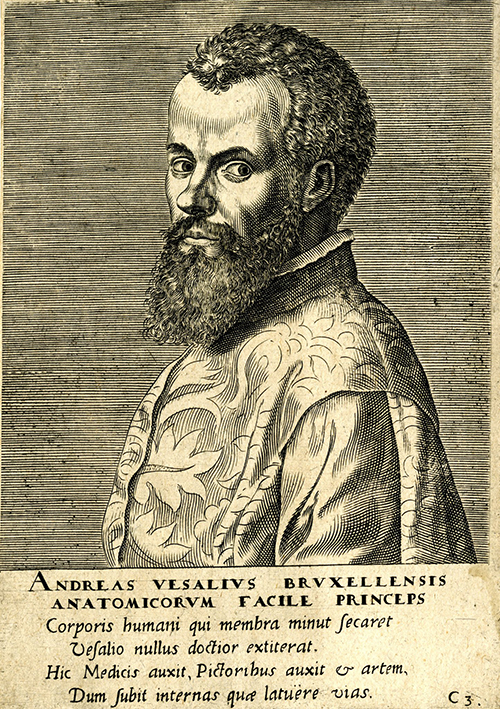De humani corporis fabrica libri septem. Basileae, ex officina Ioannis Oporini, 1543.
Suorum de humani corporis fabrica librorum epitome. Basileae, ex officina Ioannis Oporini, 1543.
 Before Vesalius, the study of anatomy was still dominated by the work and practices of the ancient Greek physician, Galen, who used dissected animals as his models. Even though early artists of the Renaissance perfected the drawing of external anatomy, dissection of the sacred human body was still against the religious ideals of the day and so the description of the internal body had not seen much improvement (Garrison 217). Flemish-born anatomist Andreas Vesalius is responsible for overthrowing the Galenic traditions and instating dissection as an essential part of anatomical study. He received his medical degree at the University of Padua, the famous center of medical education during the Renaissance, and then taught anatomy and surgery there as well, performing public dissections for his students and working on his famous anatomical writings. Vesalius’s attacks on the accepted Galenic doctrine brought heavy criticism by many respected medical scholars, including his former instructor and strict Galenist, Jacobus Sylvius. Some of the inaccurate ideas that his observation-based works disproved are Adam’s missing rib, the five-lobed liver, the two-horned uterus, the seven-segmented sternum, the double bile-duct, the interventricular pores, and hypothetic sutures in the maxillary (Clendening 126-127). Vesalius is a true model of Renaissance ideals, giving birth to the scientific study of anatomy.
Before Vesalius, the study of anatomy was still dominated by the work and practices of the ancient Greek physician, Galen, who used dissected animals as his models. Even though early artists of the Renaissance perfected the drawing of external anatomy, dissection of the sacred human body was still against the religious ideals of the day and so the description of the internal body had not seen much improvement (Garrison 217). Flemish-born anatomist Andreas Vesalius is responsible for overthrowing the Galenic traditions and instating dissection as an essential part of anatomical study. He received his medical degree at the University of Padua, the famous center of medical education during the Renaissance, and then taught anatomy and surgery there as well, performing public dissections for his students and working on his famous anatomical writings. Vesalius’s attacks on the accepted Galenic doctrine brought heavy criticism by many respected medical scholars, including his former instructor and strict Galenist, Jacobus Sylvius. Some of the inaccurate ideas that his observation-based works disproved are Adam’s missing rib, the five-lobed liver, the two-horned uterus, the seven-segmented sternum, the double bile-duct, the interventricular pores, and hypothetic sutures in the maxillary (Clendening 126-127). Vesalius is a true model of Renaissance ideals, giving birth to the scientific study of anatomy.
In his revolutionary work, De humani corporis fabrica libri septem, originally published in 1543, Vesalius provided to his contemporaries the most precise description of human anatomy they had ever seen. The woodcuts in this volume, among the most beautiful and most famous of all anatomical drawing, include a naturalistic landscape backdrop of the Paduan countryside (Heirs of Hippocrates 172). They are usually attributed to Jan Stephan van Calcar (or Kalkar), one of Titian’s pupils in Venice, but there is still some question about whether they were done by him or some other artist of the Titian school (One Hund. Books 18). However, they were drawn under the supervision of Vesalius, and are therefore anatomically accurate. Vesalius intended this work to be a textbook, and so he accompanied this publication with an epitome for students, Suorum de humani corporis fabrica librorum epitome. In the Epitome, the drawings are larger and the text is limited. Because the pages are removable, many copies of the Epitome are incomplete today, making intact copies very rare (One Hund. Books 18). The Reynolds-Finley Historical Library hold copies of the first and second editions of De fabrica as well as a complete Epitome.
Clendening, Source Book of Med. Hist., 126-127; Garrison, Hist. of Med., 4th Edition, pp. 217-219; Garrison & Morton, Med. Bib., 5th Edition, 375 & 376; Heirs of Hippocrates, 171 & 172;; Not. Med. Books, p. 29; One Hund. Books, 18; Reynolds Historical Library, Italia Medica, 9 & 10; Reynolds Historical Library, Rare books and coll…,4191 & 4202; A catal. of printed books in the Wellcome Hist. Med. Libr., Vol. I, 6560 & 6565.
Image: Andreas Vesalius, Print Collection, Reynolds-Finley Historical Library
